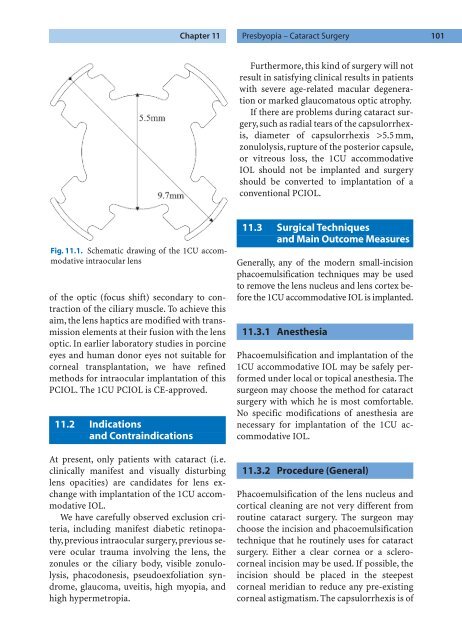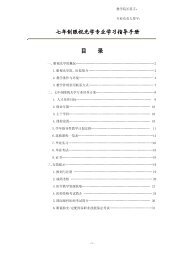Refractive Lens Surgery
Refractive Lens Surgery
Refractive Lens Surgery
You also want an ePaper? Increase the reach of your titles
YUMPU automatically turns print PDFs into web optimized ePapers that Google loves.
Fig. 11.1. Schematic drawing of the 1CU accommodative<br />
intraocular lens<br />
of the optic (focus shift) secondary to contraction<br />
of the ciliary muscle. To achieve this<br />
aim, the lens haptics are modified with transmission<br />
elements at their fusion with the lens<br />
optic. In earlier laboratory studies in porcine<br />
eyes and human donor eyes not suitable for<br />
corneal transplantation, we have refined<br />
methods for intraocular implantation of this<br />
PCIOL. The 1CU PCIOL is CE-approved.<br />
11.2 Indications<br />
and Contraindications<br />
At present, only patients with cataract (i.e.<br />
clinically manifest and visually disturbing<br />
lens opacities) are candidates for lens exchange<br />
with implantation of the 1CU accommodative<br />
IOL.<br />
We have carefully observed exclusion criteria,<br />
including manifest diabetic retinopathy,previous<br />
intraocular surgery,previous severe<br />
ocular trauma involving the lens, the<br />
zonules or the ciliary body, visible zonulolysis,<br />
phacodonesis, pseudoexfoliation syndrome,<br />
glaucoma, uveitis, high myopia, and<br />
high hypermetropia.<br />
Chapter 11 Presbyopia – Cataract <strong>Surgery</strong> 101<br />
Furthermore, this kind of surgery will not<br />
result in satisfying clinical results in patients<br />
with severe age-related macular degeneration<br />
or marked glaucomatous optic atrophy.<br />
If there are problems during cataract surgery,such<br />
as radial tears of the capsulorrhexis,<br />
diameter of capsulorrhexis >5.5 mm,<br />
zonulolysis, rupture of the posterior capsule,<br />
or vitreous loss, the 1CU accommodative<br />
IOL should not be implanted and surgery<br />
should be converted to implantation of a<br />
conventional PCIOL.<br />
11.3 Surgical Techniques<br />
and Main Outcome Measures<br />
Generally, any of the modern small-incision<br />
phacoemulsification techniques may be used<br />
to remove the lens nucleus and lens cortex before<br />
the 1CU accommodative IOL is implanted.<br />
11.3.1 Anesthesia<br />
Phacoemulsification and implantation of the<br />
1CU accommodative IOL may be safely performed<br />
under local or topical anesthesia. The<br />
surgeon may choose the method for cataract<br />
surgery with which he is most comfortable.<br />
No specific modifications of anesthesia are<br />
necessary for implantation of the 1CU accommodative<br />
IOL.<br />
11.3.2 Procedure (General)<br />
Phacoemulsification of the lens nucleus and<br />
cortical cleaning are not very different from<br />
routine cataract surgery. The surgeon may<br />
choose the incision and phacoemulsification<br />
technique that he routinely uses for cataract<br />
surgery. Either a clear cornea or a sclerocorneal<br />
incision may be used. If possible, the<br />
incision should be placed in the steepest<br />
corneal meridian to reduce any pre-existing<br />
corneal astigmatism. The capsulorrhexis is of



